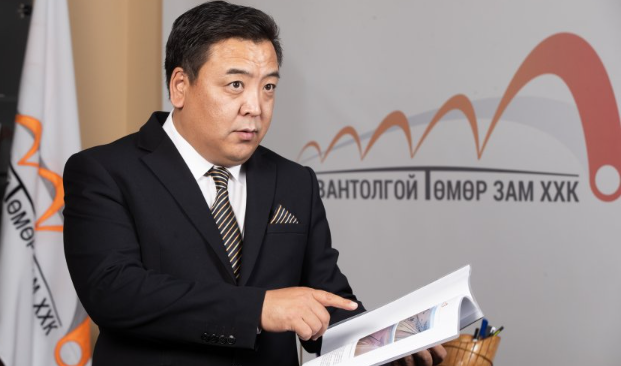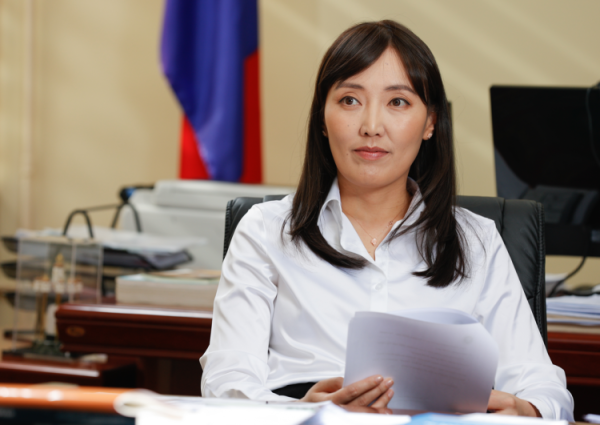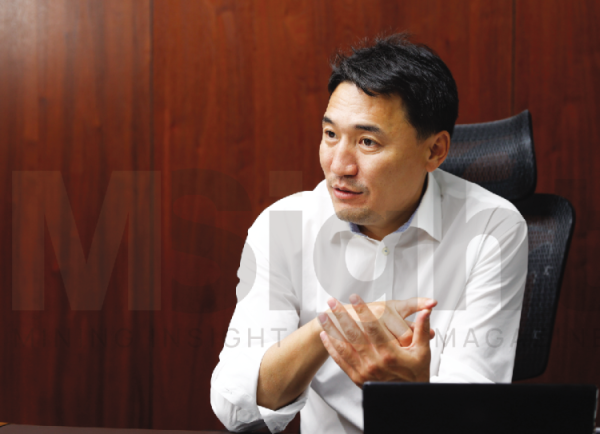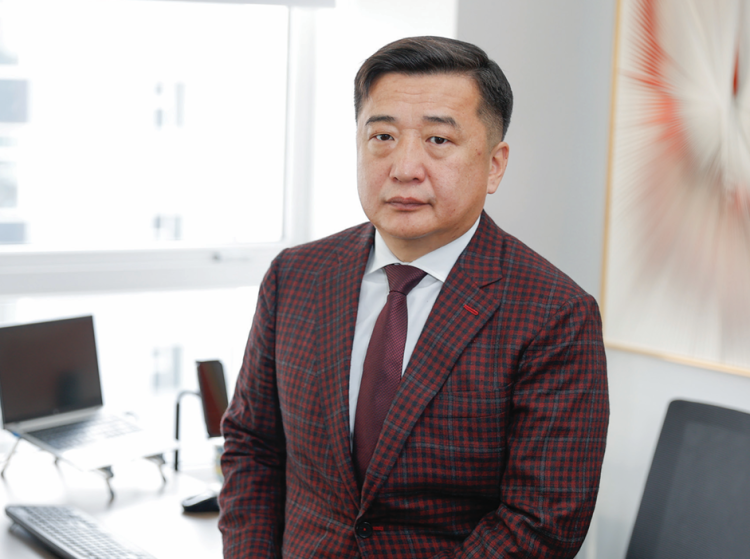 Mining Insight’s E.Odjargal talked with N.Udaanjargal, CEO of “Tavantolgoi Railway” LLC, about the development of a complex logistics project based on the Tavantolgoi-Gashuunsukhait railway, and the issue of connecting the railway across the border of the two countries.
Mining Insight’s E.Odjargal talked with N.Udaanjargal, CEO of “Tavantolgoi Railway” LLC, about the development of a complex logistics project based on the Tavantolgoi-Gashuunsukhait railway, and the issue of connecting the railway across the border of the two countries.When did the test delivery begin at the Tavantolgoi-Gashuusukhait (TT-GS) railway? How much cargo have you transported so far?
The Government approved the test delivery of TTGS to “Tavantolgoi Railway” (TTR) LLC in 2021. The Minister of Road and Transport Development issued an assessment based on an evaluation of Russian experts, officially commencing the test delivery on July 9, 2022. Under TTR’s agreement with its parent company “Erdenes Tavan Tolgoi” (ETT), TTR will transport 120,000 tonnes of freight, of which 20,000 have been delivered so far.
When will the regular operations of the railway officially begin?
We are preparing to launch the operations of the TTGS railway in September. It coincides with the “Coal Mongolia 2022” conference. Regular operations are approved after an evaluation of 10 million tonnes of cargo transportation is completed. We’ve reached this amount and are running stable operations. The State Commission accepted the TT-GS railway without any problems. A feature of Class I railroads is that they can be used directly. 200 innovative wagons arrived from Russia. The 25-tonne wagon is entering Mongolia for the first time. Our country had the opportunity to use the innovation wagon ten years later. In other words, it can be used if the main bearing capacity of UBTZ is set to 25 tonnes. That is why the TT-GS railway is called a 25-tonne technological road with no intersection. A contract was made for the acquisition of an SD70 model locomotive from the US. The arrival of A-certificate locomotives has been delayed due to global logistical complications. 800 wagons manufactured in Russia may also be delayed. But we are exploring where there is weak traction. With the arrival of these wagons and locomotives, the TT-GS railway will be able to transport 30 million tonnes of cargo.
When will the capacity of the TT-GS railway reach 30 million tonnes?
Mongolians are entering a new stage where they build their railways and estimate their use and freight. Logistics is a complex activity. Transport costs will be reduced by using railways to their maximum capacity. Our country’s exports, starting with coal and other goods, will be the main logistics. “25-year phased transportation program” was issued by TTR. In this context, we are working to reach 1 million, 5 million, 10 million, 20 million, and 30 million tonnes in stages. It will reach 30 million tonnes in the first five years. For this purpose, orientation transport will be carried out in the first three years. The target capacity of 30 million tonnes will be reached by comprehensively organizing timed activities, such as loading, transportation, and border crossing. To export this amount of cargo, 12-14 wagons per day need to be released through the port. Almost 20 wagons of cargo will be delivered to the port per day. It should not be understood that once the railway is built, everything is over. A locomotive is needed. There must be enough wagons. Professional personnel will have to be there. Loading facilities are required. Therefore, let’s clarify that it is a complete project.
I take it that there will be two types of loading facilities. One for loading from the mine and one for loading at the border. Is that correct?
TTR is implementing the “Integrated Raw Coal Loading Center” project, which is expected to reach a loading capacity of 20 million tonnes by the end of next year. TTR has started building a loading facility this year. The main process in this facility located on the mine is the crusher. 75 tonnes of coal are crushed to a uniform size and loaded into one wagon in two minutes. Fully automated facility for crushing, stacking, loading, and weighing 3,500 tonnes of coal per hour. The full capacity of the railway depends on the capacity of the loading facilities. This complex project consists of a circular loading railway at the mine, loading facilities, the main Tavantolgoi-Gashuunsukhait railway line, and the end part or border bridge facilities. At present, the main railway line is completed along with connecting two stations and the loading circle railway on the mine.
How is the situation with the railway connection across the border with China?
The key purpose of the Mongolian Prime Minister’s visit to China in 2022 was to discuss connecting the railway across the border of the two countries, which was supported by the Chinese leadership. In addition, during his recent visit to Mongolia, China’s Foreign Minister Wang Yi announced that the country’s Development and Reform Commission had given official approval to state-owned companies. Subsequently, China Energy (formerly Shenhua) will carry out the work of connecting the two countries. The logistics facility will be built with “Baoshan Railway”. “Ganchon” will manage domestic transportation in China.
Will the border crossing point be authorized officially?
The contract was signed. Representing the Mongolian government, TTR began negotiations with a company representing the Chinese government in September 2021. A working group established by the Ministry of Foreign Affairs and Ministry of Road and Transport Development was established. I was the head of the team. Later, the Ministry of Finance came into the negotiations. The Ministry of Finance of Mongolia and the Development and Reform Commission of the People’s Republic of China signed a Memorandum of Understanding. Legally, the process of amending the 1955 Mongolia-China border railway agreement will continue on both sides. Russia, Mongolia, and China used to agree on the number of trains and goods to be exchanged per day at Naushki-Altanbulag and ZamynUud-Ereen ports. With the amendment, the Gashuunsukhait-Gantsmod port will be added.
How long will it take to construct a cross-border bridge?
As a result of the negotiation, both parties have one blueprint to work on. Over 70% of cross-border bridge structures will be built in Mongolia. Mongolians will build the narrow-gauge park on the Mongolian side and China will handle the broad-gauge section leading to the Chinese side with their funds. Similarly, the Chinese side will do the work in its territory. Both broad and narrow gauge railways will be able to access the bridge structure. As such, the bridge structure on the border will be built under the International Freight Transport Agreement. Mongolian and Chinese companies are now working on the design of the bridge structure. The Chinese side proposed to prepare the design. As a continuation of the TT-GS railway, TTR will implement the construction of the bridge structure of the end section. Technically, it is estimated to take 28-30 months.
Until the bridge is built, even rail transportation will add more burden to the port’s current gateway, and won’t it cause another bottleneck similar to road transportation?
Logistical problems will not be solved until the bridge is built. Until then, it will be transferred from the railway to the road, and then it will leave the border checkpoint. It can be transported by rail, loaded into containers, and stacked at the port. A rotation track can be set up for container transportation. The number of cars crossing the border is limited. A decision is necessary from both the parent company and road transport companies. On the other hand, due to China’s strict “zero-covid” policy, both the border checkpoint and customs are facing difficulties. Therefore, per such conditions, you should not drop your railway transport but carry it as much as possible.
In how many years do you expect to recover your investment?
When we start transporting 30 million tonnes, we can recover the total capital spent on the TT-GS railway in 2.5-3 years. Profitability means that shippers will earn many times more profit by reducing logistics costs. However, it was estimated that the investment would be recovered within 17 years based on the revenue from railway transportation. The economy will pay off within three years. The financing of the TTR project will be repaid by the investors in 17 years. Now TTR is developing a plan to turn the break-even point from 7.1 years to 4 years and quickly transition to profitability. This project has three major features. The first is business, the second is comprehensive development, and the third is Mongolia’s largest logistics network. What is the freight rate of the TT-GS railway? At present, coal is transported by road to Gantsmod port in China at a price of about 50 USD per ton. Among them, auto transport companies are making a profit. This is a lost opportunity because the railway was not built. Rather, one ton of cargo will be transported to Gantsmod port by TT-GS railway for 4.1 times cheaper or 12.09 USD. The price will also increase for further export. The transport companies make profits out of it. This is a lost opportunity for delaying railway construction. All these difficulties will be solved by having a railway. The outcome of this project is a railway that Mongolia will use for 100 years.
What is the total construction cost of the TTGS railway?
The total cost has not been finalized yet. We are comparing the estimated cost of when it was first inaugurated in 2013 with the closure cost.
Which company will own the infrastructure? Is there any dispute over ownership between the two stakeholders?
There is no conflict. Funds previously invested in railway works are registered in Mongolian Railway (MTZ). It is equal to the total investment of the project and the percentage of TTR owners is set at 34 percent. MTZ manages the professional methodology related to the use and transportation of goods by ETT and railways. TTR’s function is income generation. Shareholders will decide how to allocate the profits.
What is the progress of the Bogdkhan railway project started by TTR?
A feasibility study of the Bogdkhan railway construction project has been completed. We are signing contracts at the moment. TTR will be the client, the General Staff of the Armed Forces will handle the substructure work, and Ulaanbaatar Railway (UBTZ) will be responsible for the superstructure. For the first time in Mongolia, railway tunnels and estacade (largescale bridges) will be constructed. Regardless of the localization of technology, Mongolia will not rush the groundwork because of the complex structures that will be built. All types of research are being conducted throughout the year. Only the tunnel and overpass bridge research will take another year. Once it is done, we will move on to find investment. TTR has found the first round of investment.
Will it be the second line of UBTZ expansion?
The Government of Mongolia is committed to building the Bogdkhan Railway. The project was discussed in the 1970s and abandoned at the research level in 2010. The “Port Recovery’’ policy outlines some logistics problems, starting with the passage of the main railway hub through Ulaanbaatar. A study suggests that railway transport causes traffic congestion in cities for 120-160 minutes. There are also dangerous goods (petroleum, petroleum products, flammable substances, etc.) that cannot be stopped when passing through a densely populated city. To circumvent such a situation, a railway and logistics satellite city will be established. In any case, Mongolia is going to build the railway, which has been in discussion for many years, in a way that is possible within the framework of its security and interests. Once we have it constructed, UBTZ will operate it. Matters such as investment recovery, outsourcing, or participation in the construction phase are open for UBTZ and its 50 percent owner Russia. An increase in transit cargo turnover is beneficial for any country and its shareholders.
Will TTR take part in Eastern Vertical Axis Railway projects?
Although it is our priority, we are working on the Bogdkhan railway project as instructed by the government.
The government has announced that it will move forward with the western vertical railway project. Is TTR interested in implementing this project?
TTR is a state-owned organization. In general, the state will build the railroads itself. Instead of interest, it is the duty of the TTR to be prepared if the government gives its directions. There are policy-making organizations such as the Ministry of Road and Transport Development and MTZ. TTR’s responsibility is to take action as instructed by government policies.
How do you see the implications of local companies building new national railways?
TTR is a client for two of the three newly constructed railways and an engineering consultant for one. In addition, a private company with experience in building 100 km of railways is in charge of the Zuunbayan-Khangi railway and they are performing in a short period. The road in the direction of Hangi is of great economic importance. It is significant to complete the eastern vertical railway line as early as possible. In this way, there will be multiple export routes and Mongolia’s cargo turnover will increase. Faster and cheaper exports of minerals will grow the flow of foreign exchanges into our country. First of all, there are many advantages such as maintaining export-import balance, expanding FX reserves, and economic diversification. In general, logistics brings only pluses, and nowhere in the case of minuses.
Which company is responsible for freight transportation of the TT-GS railway?
The parent company is responsible for ETT. According to the company’s policy, TT-GS railway transportation will continue until the investment in the project is recovered. This is the decision of the meeting of TTR shareholders.
Which company will own the 22 km railway connecting TT-GS and ZB-TT?
It is under the ownership of TTR. Tavan Tolgoi station will be responsible for all logistics to Zuunbayan and Gashuunsukhait. ETT will decide what kind of cargo will be sent to where.



























